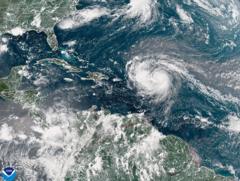Hurricane Erin has rapidly intensified into a formidable Category Five storm with maximum sustained winds recorded at 160 mph (260 km/h). According to National Hurricane Center Director Mike Brennan, this dramatic shift occurred overnight as Erin transitioned from tropical storm status on Friday. As it advances this weekend, Erin is expected to pass just north of the Leeward Islands, including the Virgin Islands and Puerto Rico, potentially bringing up to 6 inches (15 cm) of rain, which poses risks of flash flooding and mudslides.
Erin marks the first hurricane of the 2025 Atlantic hurricane season, and predictions suggest it will continue its path northward next week, moving past the eastern Bahamas and heading toward the Outer Banks of North Carolina. This movement is expected to generate life-threatening surf conditions and dangerous rip currents along nearly the entire east coast of the United States. Areas from Florida to the mid-Atlantic are particularly advised to prepare for hazardous surf conditions. Bermuda may also face significant surf and heavy rainfall.
Due to high winds, the US Coast Guard has announced restrictions for vessels in ports across the US Virgin Islands, including St Thomas and St John, as well as in six municipalities across Puerto Rico, such as San Juan. The National Oceanic and Atmospheric Administration (NOAA) anticipates an "above normal" hurricane season for the Atlantic this year, highlighting that climate change is likely leading to an increase in the frequency of storms reaching Category Four and Five intensity.


















